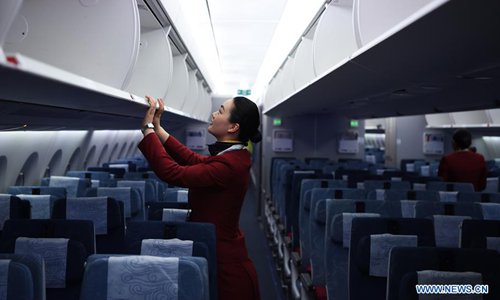Wearing masks to prevent the spread of the coronavirus was not widespread in March, when a group of German tourists took a long flight home from Israel – but researchers were surprised to find only two passengers outside the group had been infected.
In a short study published Tuesday in the US medical journal JAMA Network Open, virologists at a university hospital in Frankfurt, Germany meticulously contacted all of the passengers from the flight – none of whom had worn masks at the time – to examine the actual risk posed by the presence of travelers infected with COVID-19.
On March 9, 102 passengers boarded the Tel Aviv-Frankfurt flight that lasted four hours and 40 minutes, including a group of 24 tourists.
German authorities were alerted that the group had come into contact with an infected hotel manager while in Israel, and decided to test the 24 tourists upon their arrival in Frankfurt.
Seven of them tested positive, as did another seven later on.
Four to five weeks later, researchers contacted the 78 other passengers from the flight, 90 percent of whom responded.
The researchers asked them whom they had come into contact with and what symptoms they had, and tested several of them.
They found two passengers were most likely infected during the flight: the two people sitting across the aisle from the original seven cases.
For respiratory viruses, experts traditionally consider the contagion zone in an airplane to extend two rows of seats in front of the infected person and two rows behind.
But shockingly, a person seated in the row (seat 44K) directly ahead of two of the infected tourists (seats 45J and 45H) was not infected.
“This person from row 44 told us that he had a long conversation, and was speaking a long time with both of row 45,” Sandra Ciesek, the head of the Institute of Medical Virology in Frankfurt, told AFP, noting that made it all the more surprising he was not infected.
The two passengers seated directly behind another infected tourist did not contract COVID-19.
“We were surprised to only find two likely transmissions,” said Sebastian Hoehl, from the same Frankfurt institute.
Not all of the other passengers were tested, so researchers could not exclude that some of them might have been infected during the flight.
The study stresses that, in any case, viral transmission on an airplane is indeed possible if passengers do not wear masks.
But, Hoehl noted, “as the rate was lower than what we expected, and as none of the passengers wore masks, I think it is reassuring that we could not detect more” cases.
A stewardess checks the compartment on flight CA935 after arrival at Frankfurt Airport in Frankfurt, Germany, December 1, 2018.Photot: Xinhua




